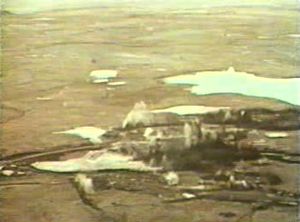Operation Flintlock (nuclear test) facts for kids
Quick facts for kids Operation Flintlock |
|
|---|---|
| Information | |
| Country | United States |
| Period | 1965–1966 |
| Number of tests | 47 |
| Test type | underground shaft, tunnel |
| Max. yield | 365 kilotonnes of TNT (1,530 TJ) |

Operation Flintlock was a series of nuclear tests carried out by the United States. These tests happened between 1965 and 1966. It was a large operation, with 47 different tests conducted underground. This series took place after Operation Whetstone and before Operation Latchkey.
Contents
What Was Operation Flintlock?
Operation Flintlock was a program where the United States tested its nuclear weapons. These tests were done to improve the design of nuclear weapons and to understand how they worked. Most of the tests were conducted deep underground. This helped to contain the explosions and prevent radioactive material from spreading into the air.
Why Test Nuclear Weapons?
Nuclear tests were important for scientists and engineers. They wanted to make sure the weapons would work as planned. These tests also helped them learn more about the effects of nuclear explosions. Some tests were even for peaceful research, like Project Plowshare, which explored using nuclear explosions for large-scale construction projects.
Where Did These Tests Happen?
Most of the tests in Operation Flintlock took place at the Nevada Test Site (NTS). This is a large area in Nevada, USA, specifically set aside for nuclear testing. One important test, called Long Shot, happened far away on Amchitka Island in Alaska. This island is part of the Aleutian Islands.
The Nevada Test Site
The Nevada Test Site was a key location for many US nuclear tests. It has different areas, and for Operation Flintlock, tests were done in various parts of the site. These underground tests involved drilling deep shafts or tunnels into the earth. The nuclear devices were then placed at the bottom of these holes before being detonated.
Amchitka Island Test: Long Shot
The Long Shot test on Amchitka Island was special. It was designed to see if underground nuclear tests could be detected from far away. This was part of a program called Vela Uniform, which aimed to improve ways to monitor nuclear explosions around the world. The Long Shot test had a yield of 80 kilotons of TNT.
Key Facts About Operation Flintlock
Operation Flintlock included a total of 47 nuclear tests. All of them were conducted underground. The largest explosion in this series was the Halfbeak test, which had a yield of 365 kilotons of TNT. A kiloton is a measure of explosive power, equal to 1,000 tons of TNT. Many of the tests had smaller yields, some less than 20 kilotons.
Types of Tests Conducted
The tests in Operation Flintlock had different purposes:
- Weapons Development: Most tests were for improving nuclear weapon designs.
- Weapon Effect: Some tests studied how nuclear explosions affected different materials or structures.
- Safety Experiment: These tests checked the safety features of nuclear devices.
- Peaceful Research: A few tests were part of Operation Plowshare, exploring non-military uses for nuclear explosions. For example, the Templar test was for developing excavation devices. The Vulcan test was for heavy element production.
Understanding Yield and Fallout
The "yield" of a nuclear test tells us how powerful the explosion was. It's measured in kilotons (kt) or megatons (Mt) of TNT. For underground tests, the goal was to contain the explosion and any fallout (radioactive material). Sometimes, "venting" was detected, meaning some radioactive gases escaped to the surface. Scientists monitored this closely.
Images for kids


